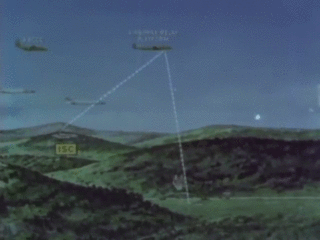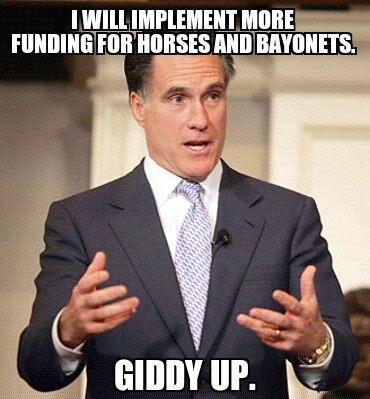The Cybernetic Jungle: Difference between revisions
Dave Young (talk | contribs) |
Dave Young (talk | contribs) |
||
| Line 20: | Line 20: | ||
On the 22nd October, the third and final 2012 US presidential debate between Barack Obama and Mitt Romney was viewed on television by almost 60 million Americans, with many more all over the world following online and offering their commentary on social media sites.<ref name="Nielsen Wire">http://blog.nielsen.com/nielsenwire/politics/final-presidential-debate-draws-59-2-million-viewers/ </ref> The two previous debates had offered moments of political surrealism, with [http://www.youtube.com/watch?v=Ilv3VLIGJzE Romney declaring his love for Sesame Street's Big Bird] followed by the bizarre turn of phrase [http://www.youtube.com/watch?v=wfXgpem78kQ "binders full of women"] in the second debate. Both moments were immortalised in the short-term memory of internet culture through a viral flurry of hashtags, blog posts, and tumblrs full of gifs. An audience of digital natives watched the debate, device in hand, waiting for another "moment" - if they were quick enough, they might get the tumblr url first. | On the 22nd October, the third and final 2012 US presidential debate between Barack Obama and Mitt Romney was viewed on television by almost 60 million Americans, with many more all over the world following online and offering their commentary on social media sites.<ref name="Nielsen Wire">http://blog.nielsen.com/nielsenwire/politics/final-presidential-debate-draws-59-2-million-viewers/ </ref> The two previous debates had offered moments of political surrealism, with [http://www.youtube.com/watch?v=Ilv3VLIGJzE Romney declaring his love for Sesame Street's Big Bird] followed by the bizarre turn of phrase [http://www.youtube.com/watch?v=wfXgpem78kQ "binders full of women"] in the second debate. Both moments were immortalised in the short-term memory of internet culture through a viral flurry of hashtags, blog posts, and tumblrs full of gifs. An audience of digital natives watched the debate, device in hand, waiting for another "moment" - if they were quick enough, they might get the tumblr url first. | ||
The supposed subject of the debate was foreign policy, although Obama's US military policies were drawn into the spotlight on numerous occasions, eventually giving rise to a minor highlight of what was generally deemed a dull debate. Romney pressed Obama on cuts to the US military: | The supposed subject of the debate was foreign policy, although Obama's US military policies were drawn into the spotlight on numerous occasions, eventually giving rise to a minor highlight of what was generally deemed a dull debate. Romney pressed Obama on planned cuts to the US military budget: | ||
::"You mention the Navy, for example, and the fact that we have fewer ships than we did in 1916. Well Governor, we also have fewer horses and bayonets."<ref name="The Atlantic: 'Horses and Bayonets' Goes from Obama's Mouth to Parody Tumblr in 9 Minutes">http://www.theatlanticwire.com/politics/2012/10/it-took-less-30-minutes-horses-and-bayonets-become-meme/58227/</ref> | ::"You mention the Navy, for example, and the fact that we have fewer ships than we did in 1916. Well Governor, we also have fewer horses and bayonets."<ref name="The Atlantic: 'Horses and Bayonets' Goes from Obama's Mouth to Parody Tumblr in 9 Minutes">http://www.theatlanticwire.com/politics/2012/10/it-took-less-30-minutes-horses-and-bayonets-become-meme/58227/</ref> | ||
Cue a barrage of collage: Obama's face photoshopped onto scenes from the American Civil War; mash-ups now featuring binders full of women, horses, and bayonets; and numerous gifs featuring Mitt Romney and unicorns. But the noise that followed Obama's wry comment drowned out a more pertinent point that is indeed worth investigating. The US military is currently undergoing a major phase of rationalisation: in January 2012, Obama announced a defence review, stating that he planned to cut $500bn from the Pentagon's budget over the next ten years. <ref name="BBC: Obama unveils new strategy for 'leaner' US military">http://www.bbc.co.uk/news/world-us-canada-16430405</ref> | Cue a barrage of collage: Obama's face photoshopped onto scenes from the American Civil War; mash-ups now featuring binders full of women, horses, and bayonets; and numerous gifs featuring Mitt Romney and unicorns. But the noise that followed Obama's wry comment drowned out a more pertinent point that is indeed worth investigating. The US military is currently undergoing a major phase of rationalisation: in January 2012, Obama announced a defence review, stating that he planned to cut $500bn from the Pentagon's budget over the next ten years. <ref name="BBC: Obama unveils new strategy for 'leaner' US military">http://www.bbc.co.uk/news/world-us-canada-16430405</ref> | ||
==References== | ==References== | ||
Revision as of 12:38, 25 October 2012
The Cybernetic Jungle
Like many controversial conflicts during the Vietnam war, "Operation Igloo White" remains somewhat obscured to popular history. Considering its great potential as another bombastic propaganda film illustrating the ingenuity of the US military and its patriotic spirit, it is perhaps surprising that it hasn't yet been given the full Michael Bay stars 'n' stripes treatment. Then again, one probable reason why Igloo White: The Movie hasn't featured in a cineplex near you is that it is considered to be a major military controversy, and another entry on the long list of induced 'Nam amnesia.
Despite its failure, Igloo White was an important precursor to the kind of remote-controlled warfare those in Pakistan have to undergo on a weekly basis today. It set the precedent of ordinary soldiers fighting on the frontline from a computer terminal in a bunker, distant from the battlefield itself. While similar endeavors were explored during World War II and the MAD, early decades of the Cold War, Igloo White could be seen as the field test for contemporary drone warfare, and in this way only could it be deemed a worthwhile campaign.
As with the majority of US military campaigns featuring experimental technologies, the raw materials for Igloo White were developed at MIT in the late 1960s with a R&D group known as JASON. The idea was to create a network of sensors along the Ho Chi Minh Trail, a transport route of strategic importance that ran through the jungles of North Vietnam into the South, through Laos and Cambodia. A variety of sensors were used in the operation: vibration sensors to detect movement of truck convoys, microphones to pick up the speech of the enemy soldiers, and even sensors that could detect the scent of urine. [1] The sensors were mostly dispersed by air - like seedlings, designed to embed themselves in the ground and appear like small plants, or get caught in the jungle canopy disguised amongst the trees, quietly emitting data streams via radiowaves. The result was a cybernetic jungle, a natural space invaded by micro-computers broadcasting a symbolic representation of their environment.
The network was controlled and observed from a US military command center (the Infiltration Surveillance Center - ISC) hundreds of kilometers to the North West in Nakhom Phanom, Thailand. Soldiers would turn up for work in a windowless bunker in full uniform, watching over the network for unusual patterns in the incoming data that might suggest suspicious activity. By analysing the data collected from a number of sensors proximate to one another, the size of a convoy could be ascertained, and perhaps what type of vehicles are being used. The soldier could then order an air strike of the area:
- "The planes' navigation systems and computers automatically guided them to the "box", or map grid square, to be attacked. The ISC central computers were also able to control the release of bombs: the pilot might do no more than sit and watch as the invisible jungle below suddenly exploded into flames. In most cases, no American ever actually saw the target at all."[1]
Through this remote system, the enemy is replaced by symbols that represent the enemy: flows of numbers, or a glowing white light on a computer monitor. The only sensor that apparently managed a direct representation of the enemy was the microphone, relaying the voices and sounds back to the ISC where it could be recorded to tape for later analysis. But indeed, by abstracting the human-enemy into a continual data stream, a paranoid curiosity can begin to take over: how do I know this symbol signifies the actual presence of the enemy? Is it a glitch? Is the enemy playing tricks on me?
At a cost of about one billion US dollars per year to operate, Operation Igloo White was hardly an incidental military investment. The expected return was control over the regional logistics, and to further the policy of containment. Operation Igloo White was declared a great success by the US, but in truth the figures detailing the cost of destruction to the Vietcong were greatly inflated. The amount of airstrikes triggered and delivered by the network may have indicated a victory of vast destruction, but after further analysis, the statistics did not make sense. The Americans had claimed the destruction of a number of trucks along the trail that exceeded some estimates of the number of trucks in the entire country at the time.
- "The guerillas had simply learned to confuse the American sensors with tape-recorded truck noises, bags of urine, and other decoys, provoking the release of countless tons of bombs onto empty jungle corrdoes, which they then traversed at their leisure." [1]
The curious paranoiac would have been right to become anxious: the Vietnamese soldiers began to learn and adapt to the cybernetic jungle, using the assumption that the sensors broadcast an objective truth to their advantage.
Horses and Bayonets and Unbodied Soldiers, Oh My!
On the 22nd October, the third and final 2012 US presidential debate between Barack Obama and Mitt Romney was viewed on television by almost 60 million Americans, with many more all over the world following online and offering their commentary on social media sites.[2] The two previous debates had offered moments of political surrealism, with Romney declaring his love for Sesame Street's Big Bird followed by the bizarre turn of phrase "binders full of women" in the second debate. Both moments were immortalised in the short-term memory of internet culture through a viral flurry of hashtags, blog posts, and tumblrs full of gifs. An audience of digital natives watched the debate, device in hand, waiting for another "moment" - if they were quick enough, they might get the tumblr url first.
The supposed subject of the debate was foreign policy, although Obama's US military policies were drawn into the spotlight on numerous occasions, eventually giving rise to a minor highlight of what was generally deemed a dull debate. Romney pressed Obama on planned cuts to the US military budget:
- "You mention the Navy, for example, and the fact that we have fewer ships than we did in 1916. Well Governor, we also have fewer horses and bayonets."[3]
Cue a barrage of collage: Obama's face photoshopped onto scenes from the American Civil War; mash-ups now featuring binders full of women, horses, and bayonets; and numerous gifs featuring Mitt Romney and unicorns. But the noise that followed Obama's wry comment drowned out a more pertinent point that is indeed worth investigating. The US military is currently undergoing a major phase of rationalisation: in January 2012, Obama announced a defence review, stating that he planned to cut $500bn from the Pentagon's budget over the next ten years. [4]
References
- ↑ 1.0 1.1 1.2 Edwards, Paul N. Closed World: Computers and the Politics of Discourse in Cold War America (1996) p3-8
- ↑ http://blog.nielsen.com/nielsenwire/politics/final-presidential-debate-draws-59-2-million-viewers/
- ↑ http://www.theatlanticwire.com/politics/2012/10/it-took-less-30-minutes-horses-and-bayonets-become-meme/58227/
- ↑ http://www.bbc.co.uk/news/world-us-canada-16430405


